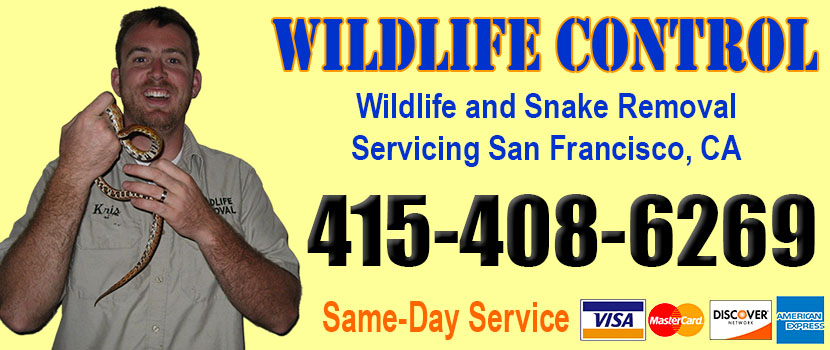
Welcome to sanfranciscosnakes.com! I am David, a snake enthusiast living in San Francisco, CA. Many people don't know that San Francisco is in fact full of snakes! You just need to know where to find them - they can often be shy and elusive. Some California snake species are more common outside of the city limits, in different parts of San Francisco County CA, but many types of snakes are indeed common in the more urban parts of San Francisco. This guide is meant to help educate you about the beautiful snakes of San Francisco, and to help you identify the most common snakes of San Francisco, as well as the venomous snakes of San Francisco that you should learn to recognize and avoid. If you want more detail, click here for my complete list of ALL snake species in San Francisco. Remember the following:
- Most snakes of San Francisco are harmless and don't want to encounter you
- Venomous snakes exist but are uncommon in San Francisco, California
- Snakes eat rats and mice and are a valuable part of the California ecosystem
- Never kill a snake - if you leave a snake alone, it will leave you alone.
Common Snake Species in San Francisco
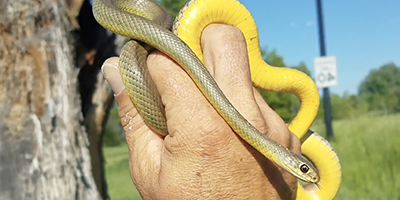 Western Yellow-Bellied Racer:
A speedy snake found across northern and central California, they’re typically around three feet in length, though they can grow much longer. This with large heads, they come in a
variety of colors due to the wide range of habitats. Generally, though, they are some variation of brown, green, or yellow. The young are very brightly colored and were once thought to be a different species. Fast and an aggressive biter if aggravated, they’re active during the day and prefer to stay on the ground, though they are excellent climbers if forced. Not a picky eater, they will go after small birds, mammals, frogs, large insects, and other reptiles. Fond of open meadows and grasslands, though as stated previously they can live just about anywhere across the state.
Western Yellow-Bellied Racer:
A speedy snake found across northern and central California, they’re typically around three feet in length, though they can grow much longer. This with large heads, they come in a
variety of colors due to the wide range of habitats. Generally, though, they are some variation of brown, green, or yellow. The young are very brightly colored and were once thought to be a different species. Fast and an aggressive biter if aggravated, they’re active during the day and prefer to stay on the ground, though they are excellent climbers if forced. Not a picky eater, they will go after small birds, mammals, frogs, large insects, and other reptiles. Fond of open meadows and grasslands, though as stated previously they can live just about anywhere across the state.
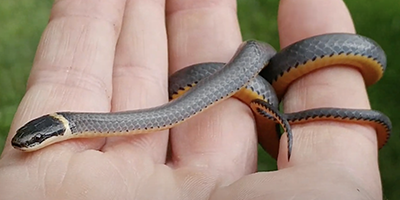 Pacific Ring-necked Snake:
Named for the colored ring around their neck, these smaller snakes are usually only a foot in length. Grey, blue, olive, or black in body color, with an orange or yellow underside, they eat salamanders, tadpoles, frogs, worms, slugs, lizards, and other snakes. They have a mild venom that is harmless to people. Elusive by nature, they tend to live under brush, leaves, and rocks, though they will come out at night or if it’s cloudy.
Pacific Ring-necked Snake:
Named for the colored ring around their neck, these smaller snakes are usually only a foot in length. Grey, blue, olive, or black in body color, with an orange or yellow underside, they eat salamanders, tadpoles, frogs, worms, slugs, lizards, and other snakes. They have a mild venom that is harmless to people. Elusive by nature, they tend to live under brush, leaves, and rocks, though they will come out at night or if it’s cloudy.
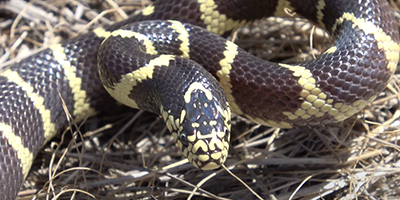 California King Snake:
These constrictors can reach four feet but are usually closer to three feet in length. They have a varied color pattern but are generally a dark body color like brown or black with lighter bands along their body. In cooler weather, they’ll be active during the day but when it’s hotter they will move about at dawn and dusk or night instead. Immune to rattlesnake venom, king snakes eat just about anything they can swallow. Their habitat is just as varied as their diet, due to their wide range across the state.
California King Snake:
These constrictors can reach four feet but are usually closer to three feet in length. They have a varied color pattern but are generally a dark body color like brown or black with lighter bands along their body. In cooler weather, they’ll be active during the day but when it’s hotter they will move about at dawn and dusk or night instead. Immune to rattlesnake venom, king snakes eat just about anything they can swallow. Their habitat is just as varied as their diet, due to their wide range across the state.
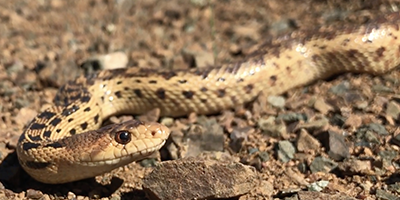 Pacific Gopher Snake:
One of several subspecies of such snakes in California, they are usually around five feet in length. They are generally brown or tan in coloration, with dark blotches and a cream or yellow underbelly. Incredibly common across the state, they mostly eat small mammals. A constrictor, their activity depends on the weather. If it’s cool out they’ll be active during the day, and if hotter they will move about at night instead. They have a varied habitat and can be found just about anywhere in the state.
Pacific Gopher Snake:
One of several subspecies of such snakes in California, they are usually around five feet in length. They are generally brown or tan in coloration, with dark blotches and a cream or yellow underbelly. Incredibly common across the state, they mostly eat small mammals. A constrictor, their activity depends on the weather. If it’s cool out they’ll be active during the day, and if hotter they will move about at night instead. They have a varied habitat and can be found just about anywhere in the state.
Venomous Snake Species in San Francisco
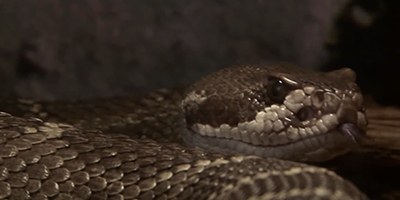 North Pacific Rattlesnake:
One of several subspecies of rattlesnake found in California, these highly venomous snakes inhabit a wide range across northern and central portions of the state. Generally, over a foot to three feet in length, they do occasionally grow longer. Due to their wide range of habitat, their coloration varies, but brown and blotched are a good start. Nocturnal for the most part, these pit vipers feed mostly on mammals, though they will eat reptiles, frogs, insects, and birds as well. Adult California ground squirrels are immune to rattlesnake venom and tend to fight back when a rattler tries to eat them.
North Pacific Rattlesnake:
One of several subspecies of rattlesnake found in California, these highly venomous snakes inhabit a wide range across northern and central portions of the state. Generally, over a foot to three feet in length, they do occasionally grow longer. Due to their wide range of habitat, their coloration varies, but brown and blotched are a good start. Nocturnal for the most part, these pit vipers feed mostly on mammals, though they will eat reptiles, frogs, insects, and birds as well. Adult California ground squirrels are immune to rattlesnake venom and tend to fight back when a rattler tries to eat them.
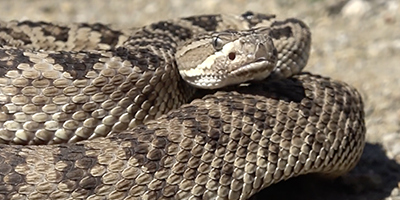 Great Basin Rattlesnake:
Another dangerous and widely habituating rattlesnake, this one is usually three to four feet in length, though they can be shorter or longer. These rattlers tend to be lighter in color, with a pale belly. They eat small mammals, birds, frogs, insects, and other reptiles. They can be found across northern and central California, where it shares its range with several other subspecies and species of rattlesnake. Like most of its species, they will rattle their tail if aggravated and will bite if threatened. Caution is always advised when it comes to venomous snakes, especially ones well camouflaged like rattlers tend to be in their native habitats.
Great Basin Rattlesnake:
Another dangerous and widely habituating rattlesnake, this one is usually three to four feet in length, though they can be shorter or longer. These rattlers tend to be lighter in color, with a pale belly. They eat small mammals, birds, frogs, insects, and other reptiles. They can be found across northern and central California, where it shares its range with several other subspecies and species of rattlesnake. Like most of its species, they will rattle their tail if aggravated and will bite if threatened. Caution is always advised when it comes to venomous snakes, especially ones well camouflaged like rattlers tend to be in their native habitats.
If you're unsure, you can email me a photo of the snake at info@sanfranciscosnakes.com and I will email you back with the snake's species. If you found a snake skin, read my Found a Skin? page, and you can email me a photo of the skin, and I'll identify the snake for you. If you need professional San Francisco snake removal help, click my Get Help page, or see the below website sponsor I found, who provides that service.
How do snakes kill their prey?
Different snakes have different techniques when it comes to hunting and consuming prey. All species are capable of dislocating their own jaws, making them wider and allowing for larger prey items to fit in. There is still a limit to how large a prey item the snake can chase after, however, and it would be quite unusual to come across a snake that had “eyes bigger than its belly,” so to speak. Snakes usually have a pretty good idea of what size prey to go after, and what prey-chase could end up being potentially dangerous to them.
Some snake species will have a toxic venom that they inject into the victim. Again, the kind of toxic outcome will depend on the species of snake. Some will have venom that paralyzes the prey, and also starts working on digesting the body to make it easier for the snake to consume. Bizarrely, scientists have recently discovered that the venom found in these venomous snakes is closely related to the saliva that we can find in our own human mouths. In many ways, it is virtually the same, with just a few protein differences. The snakes have evolved to have saliva that works in their favor.
There are three types of venom — Cytotoxic, Neurotoxic, Hemotoxic. The latter (Hemotoxic) will hit the blood with an aim to disable the cardiovascular system and heart. As the name suggests, Neurotoxic venom will have an impact on the brain, affecting the way that the nervous system works. Cytotoxic is slightly less dangerous in many cases, usually only working on a small and rather localized area.
Some snakes will have venom that uses just one of those toxic effects, but some snakes can have a combination of “ingredients” in their venom to make them all the more deadly.
“Elapidae” snakes are the most dangerous of venomous snakes, including the Sea Snake, Coral Snake, Tiger Snake, Taipan Snake, Mamba and Coral Snake. The venom of these snakes is incredibly fast acting. They have short and narrow teeth, which means that they don't do the greatest job in latching on to prey. In order to counteract this, their toxicity works very quickly. The muscles are very quickly paralyzed, an effect that works around the entire body. In small prey items, this paralysis will happen almost immediately. In larger animals, it can take hours for it to take full effect. In many cases, however, the short and hollow teeth make the bite almost painless. It is often the case that victims are unaware that they have even been bitten.
If you want a painful bite, you'll need to look at snakes that come from the “Viperidae” family. These include the Copperhead Snake, Adder, Bushmaster, Rattlesnake, and Viper. These teeth are much longer than the ones we mentioned above, and they even fold into the mouth. The venom isn't quite as toxic with this snake, but it doesn't need to be quite as fast-acting. The longer fangs mean that the snake has a pretty good hold on its prey for a while, giving it longer to inject more of the toxic venom in. Generally, these bites have localized issues, with tissue damage and sometimes problems with the blood or circulatory system. In severe cases, limbs may need to be amputated to stop problems associated with this kind of snake bite.
The “Colubridae” family of snakes make up almost two-thirds of the rest of the snake species that are venomous — Vine and Rat snakes, for example. These have different kinds of venom, working in a number of different ways, combining the types of snake venom we have already discussed.
Snakes that don't use venom to kill or overpower their prey will rely on another method — constriction. Wrapping themselves around their prey as tightly as they can, it could be a number of things that eventually finishes the animal off, but the main point to make is that it gets the job done. These are usually larger snakes, with thicker and more powerful bodies. They need strength on their side to be able to overpower a larger prey item without something toxic on their team.
Once the prey has been overpowered, in whatever way the snake has managed to do that, it is then time to feast. This is where things get really interesting. Snakes can open their jaws and mouths a lot wider than other animals, splitting the entire thing into four almost entirely separate sections. This gives them a bigger hole in which to push food in through, and can often mean that they can consume prey items that are much larger than they are.
Strong muscles pull the prey in from the inside, and they force the food down too, towards the stomach and stomach acid. The muscles will already start to pulp down the food, making it softer and easier for the snake to digest. This can take quite a long period of time, and will leave the snake sluggish, slow, and open to predatory attacks.
Remember, the term is not poisonous snakes of San Francisco, it's venomous snakes of San Francisco. Poison is generally something you eat, and venom is injected into you. That said, dangerous snakes are very rare in San Francisco. The few venomous snakes of San Francisco County are rarely seen. But they are commonly misidentified, so learn about all the snake species of San Francisco in order to correctly identify them. These snakes are usually also found in the surrounding towns of Amanico Ergina Village, Banneker Homes, Bayside Village, Bayview District, Chinatown, Diamond Heights Village, Doelger City, Eldton, Forest Hill, Forest Knolls, Fort McDowell, Fort Winfield Scott, Frederick Douglass Haynes Gardens, Friendship Village, Glenridge, Gold Mine Hill, Golden Gate Heights, Haight-Ashbury, Ingleside, Ingleside Heights, Ingleside Terrace, Jordan Park, Laguna Heights, Little Italy, Little Osaka, Loren Miller Homes, Malcolm X Square, Marcus Garvey Square, Marina District, Martin Luther King Square, Merced Heights, Merced Manor, Mission District, North Beach, North Point Public Housing, Oceanview, Opera Plaza, Pacific Heights, Park Merced, Park View Commons, Potrero District, Presidio Terrace, Richmond District, Saint Francis Square, Saint Francis Wood, Seacliff, Sherwood Forest, Silver Terrace, Stonestown, Sunset District, Thomas Paine Square, Valencia Gardens, Victoria Mews, Village Square, Vista Del Monte, West Portal, Western Addition, and the surrounding areas.
Read our article about:
Can all snakes swim?
sanfranciscosnakes.com domain and hosting costs made possible by the generous support of this sponsor:
